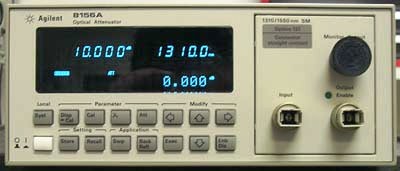
|
|
The HP 8156A Optical Attenuator can be used in both single- and multimode applications. Each optical attenuator is calibrated over its entire 60 dB range at 1310 and 1550 nm. In addition, wavelength characteristics of the instrument are stored in an EEPROM. This allows an automatic correction to be performed for every wavelength and attenuation setting. The Agilent 8156A enables you to attenuate any optical signal up to 60 dB in precise steps over its entire wavelength range. A resolution of 0.001 dB lets you achieve the exact signal power required for your measurement with a repeatability of better than 0.005 dB. Maximum input power is +23 dBm. The Agilent 8156A is available with three different return loss options ranging from 35 dB to 60 dB. The HP 8156A can be used as calibrated and programmable back reflector to check the increase in bit error rate or noise performance as a function of the back reflection level. During your bit error rate measurements you may want to monitor the power level at the receiver input. Instead of using a separate coupler, the HP 8156A offers a built-in 13 dB coupler as an option. Specifications. Attenuation range is 60 dB with 0.001 dB resolution. Wavelength: 1200 nm to 1650 nm. Fiber type: 9/125 µm SM (opt. 100, 101, 121, 201, 221), 50/125 µm MM (opt. 350). Connector type: straight (opt. 100, 101, 121, 350), angled (opt. 201, 221). Return loss: >35dB (opt. 100), >45dB (opt. 101,121), >60db (opt.201, 221), 22dB (opt.350). Maximum input power: +23 dBm. Options. Opt 100: Standard performance version. Opt 101: High performance version. Opt 201: High performance, high return loss version. Opt 350: 50/125 µm multimode option. Opt 121: High performance version, monitor output. Opt 221: High performance, high return loss version, monitor output. Opt 203: Back reflector kit for option 201 and option 221 (consists of 1 each HP 81000SI, 81000FI, 81113PC, 81000UM, 81000BR).
|